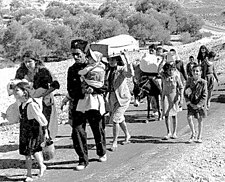Nasr Al-Din, Palestine
In the 1948 Palestine war, the village was destroyed and its residents expelled as part of the 1948 Palestinian expulsion.
History
Archeological excavations has shown that the place was inhabited in the Hellenistic era, and that a major settlement was here during the Roman era, in 2nd to 4th century CE.
Nasir ad-Din is named after a shrine dedicated to Nasir ad-Din, an Ayyubid general who died while fighting the Crusaders and buried to the north of the village, according to local legend. A kilometer to the west is the shrine for another Muslim soldier who died fighting the Crusaders, named Sheikh al-Qaddumi.
British Mandate era
In the 1922 census of Palestine, conducted by the British Mandate authorities, Nasir al Din had a population of 109, all Muslims, increasing in the 1931 census to 179, still all Muslims, in 35 houses.
During the British Mandate in Palestine, most of Nasir ad-Din's houses were scattered north–south, with no particular village plan. The inhabitants worked in agriculture and animal breeding.
In the 1944/1945 statistics the population consisted of 90 Muslims, and together with the people of Al-Manara they had 4,185 dunams of land. Of this, 4,172 dunams of land were used for cereals, while 13 dunams were classified as built-up (urban) area.
1948 war and destruction
 |
| Part of a series on the |
| Nakba |
|---|
On April 12, 1948, a company from the 12th battalion of Israel's Golani Brigade captured Nasir ad-Din to cut off Tiberias from major Arab centers to the west (Nazareth and Lubya). The skirmish lasted four hours because the Haganah encountered unexpected local resistance. Historian Saleh Abdel Jawad writes that 12-20 civilians were "massacred by machine guns." Most of the inhabitants fled to Tiberias or Lubya — British troops escorted villagers to Lubya. The Haganah reported 22 Arabs were killed, six wounded, and three captured. The civilian deaths included seven men, at least one woman, and a number of children. Two Haganah troops were also wounded.
The capture and killing in Nasir ad-Din was a decisive factor for the flight of Arabs from Tiberias, and was a major demoralizing factor for Arab forces. Historian Benny Morris reports that some Palestinians at the time described the attack as "a second Deir Yassin", in reference to the highly publicized Deir Yassin massacre which had occurred days prior. All the houses were destroyed, and residents that remained were expelled on April 23.
References
- ^ Palmer, 1881, p. 131
- ^ Morris, 2004, p. xvii, village #97. Also gives causes of depopulation.
- ^ Government of Palestine, Department of Statistics. Village Statistics, April, 1945. Quoted in Hadawi, 1970, p. 72
- ^ Department of Statistics, 1945, p. 12
- ^ Mills, 1932, p. 84
- ^ Khalidi, 1992, p. 534
- ^ Abu-‘Uqsa, 2008, Tiberias, Khirbat Nasir ed-Din East
- ^ Barron, 1923, Table XI, Sub-district of Tiberias, p. 39
- ^ Government of Palestine, Department of Statistics. Village Statistics, April, 1945. Quoted in Hadawi, 1970, p. 123
- ^ Government of Palestine, Department of Statistics. Village Statistics, April, 1945. Quoted in Hadawi, 1970, p. 173
- ^ Jawad, S.A. (2007). Zionist Massacres: the Creation of the Palestinian Refugee Problem in the 1948 War. "12 April 1948: Nasir al-Deen and Sheikh Qadumi hill (Tiberias area): Indiscriminate killings occur. The two locations are attacked by Haganah’s Golani Brigade to aid the demoralisation of the besieged city of Tiberias. 12-20 civilians are massacred by machine guns and homes in Nasir al-Deen and Sheikh Qadumi are blown up. The majority of the dead are women and children."
- ^ Morris, 2004, p. 183
- ^ Benny Morris, The Birth of the Palestinian Refugee Problem Revisited (2004), "The Arabs subsequently alleged that ‘there had been a second Deir Yassin’ in Nasir ad Din – and, indeed, some non-combatants, including women and children, were killed."
- ^ Morris, 1987, p. xv, 71. Quoted in Khalidi, 1992, p. 534
Bibliography
- Abu-‘Uqsa, Hanaa (2008-08-10). "Tiberias, Khirbat Nasir ed-Din East". Hadashot Arkheologiyot (120). Hadashot Arkheologiyot – Excavations and Surveys in Israel.
- Barron, J.B., ed. (1923). Palestine: Report and General Abstracts of the Census of 1922. Government of Palestine.
- Department of Statistics (1945). Village Statistics, April, 1945. Government of Palestine.
- Hadawi, S. (1970). Village Statistics of 1945: A Classification of Land and Area ownership in Palestine. Palestine Liberation Organization Research Center.
- Khalidi, W. (1992). All That Remains:The Palestinian Villages Occupied and Depopulated by Israel in 1948. Washington D.C.: Institute for Palestine Studies. ISBN 0-88728-224-5.
- Mills, E., ed. (1932). Census of Palestine 1931. Population of Villages, Towns and Administrative Areas. Jerusalem: Government of Palestine.
- Morris, B. (2004). The Birth of the Palestinian Refugee Problem Revisited. Cambridge University Press. ISBN 978-0-521-00967-6.
- Palmer, E.H. (1881). The Survey of Western Palestine: Arabic and English Name Lists Collected During the Survey by Lieutenants Conder and Kitchener, R. E. Transliterated and Explained by E.H. Palmer. Committee of the Palestine Exploration Fund.
External links
- Welcome to Nasir-al-Din
- Nasir al-Din, Zochrot
- Survey of Western Palestine, Map 6: IAA, Wikimedia commons
- Nasir al-Din, from Khalil Sakakini Cultural Centre
